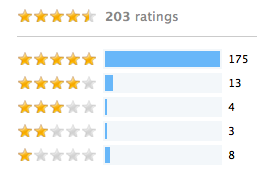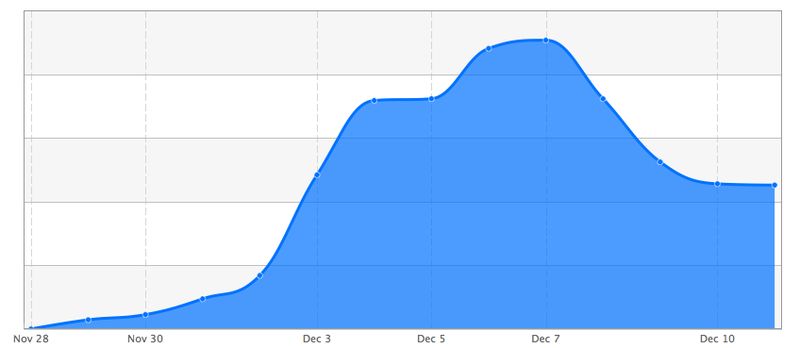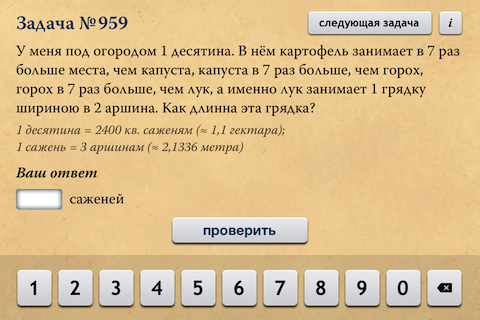How the idea wins marketing, and rural children a calculator. In mind
Instead of the preface
Walking on Saturday with friends on the same Moscow square. Around festive, a lot of people. A good friend with an exceptionally liberal education, working in sales, suddenly turns and says: “Listen, I forgot to say: you saved me from boredom with my application. The brain is boiling, very cool! Especially non-metric system pleases. ”
Sunday evening. The bell rings on the mobile: “Hello, Anton? Listen, here in task 925 there is no hint with the translation of vertices into arshins. Do not forget to fix it in the update! ”And this is a man who on Friday complained that it’s hard to count in his mind, there is not enough endurance.
Monday. I sit next to the house in a coffee shop, appending the version 1.1 code. A man in his thirties enters. Nice coat, suit. Takes coffee, pulls out an iPad and opens the news. After 15 minutes, I see a familiar screen. I say: "I am a developer!" He: "You're lying?" Showed a passport, talked.
')
About people and reforms
As for iOS applications, we have a small team. One ideologue, one designer, yes your humble servant writes the code. At the designer, I pray. He is very intelligent, fast, and indeed the best! One day, he will stop sending graphics for the Retina with an odd width / height, then I will give him something cool. Our ideologist is the real one: true to the idea that people can be shown beautiful mathematics. Of all the three, I am the most bummed. But our code always shines and shimmers. Each design pattern file has more variables than variables.
It all started with the fact that the ideologue with the designer decided to accelerate me, let's say. An action “app for the week” was announced, which dragged on, but brought unexpected results. The first joy befell me at the moment when I was informed that almost the entire schedule was already ready and was in the archive in my mail. The second was that the idea of the application is very simple - to implement the Rachinsky problem book.
Raczynski, account, in mind
Have you been to the Tretyakov Gallery for a long time? Thanks to my parents, I spent all my childhood there. And over the past year I have been given to accompany there two impressive groups of foreign mathematicians. What is the connection between Russian art of the XIX century and mathematics? Remember this example?

Even if you do not remember, not very scary. I'll explain now. The century before last was such a remarkable biologist, Sergey Alexandrovich Rachinsky . He studied abroad, wrote serious work, became a professor. And then he left everything and went to the village to teach peasant children. In addition to his work in biology, he left behind several manuals on mathematics, in particular, “1001 problems for mental counts.” And the above example of the village children decide in their minds on the painting of Bogdanov-Belsky, which captures the teaching process of Sergei Alexandrovich. Here she is:

So, we will translate “1001 tasks” into i-type. Only for the Russian-speaking user. Of course, for free.
About interactivity
I will say a little about the idea itself. It seems to me that the potential of interactive books is just beginning to unfold. If no one doubted that they would play and read mail on tablets, now serious people buy subscriptions for tablet and mobile versions of magazines. Only these magazines are not so far removed from their browser versions. The most important thing is still to come: real user interaction.
When we talk about a mathematical problem book, the interaction is defined very clearly. Especially when you consider that you need to decide in your mind, then there remains only the input field of the answer, yes, verification. Many thanks to the people who prepare and reconcile tasks. The work is very ungrateful. I’ll say right away that there are already a lot of them in the current version, but far from everything.
Important decisions
In programming, there is an important principle: "Program from the interface, not its implementation." Absolutely similar advice can be given to the creators of mobile applications: "Push off from the idea, not its implementation." I don’t want to say that implementation can limp. If we talk about our team, then such perfectionists have gathered here that normal people would have been sitting in mental hospitals for a long time about how a pixel is fitted to a pixel, texts and code pieces are copied (the last ten times). And not because it was bad, but because we figured out how to do better. But behind all this disgrace, there must necessarily be an idea. Because users are not fools. They can complain about the missing functionality, swear at the design, but if they are not hooked, even such a response will not.
Immediately agreed that we cut the functionality to the maximum. Since all the tasks are difficult to prepare for the first version (the rest will appear with the updates), we leave only those with a positive response. Task list? Not yet. What remains? Two modes: to decide in a row and "in random order." I got the answer, checked - the next one. No statistics, no save. Even there is no multitasking. Minimalism in its pure form: the task number, the test, the reference for the values (and then they did not count in meters or kilograms). The inscriptions were moved, the texts were rewritten, the code is akin to the F1 car (which is cleverly hidden in the “penny” body). No guys! Too heaped up application. We remove the "decide in order" mode, make the last build and send it for review in the App Store.
Perspectives
When you or your team develop an application, remember that you can adequately evaluate it only from the outside. Our children will always be for us the most beautiful, intelligent, capable and wonderful. And, of course, they cannot provoke a fight, feign disease, in order not to go to school, not listen to the teacher of their own accord (at worst, the teacher will be accused of being unprofessional) and so on.
As a person who still hopes to devote his life to science, it is very difficult for me to assess the prospects and relevance of this or that product of popularization. Despite innate skepticism, some hope arose when one of the humanitarian comrades sank into a mental score for the good ten minutes as soon as he was given a beta-version device. In general, popularization still remains an experimental science for me: I could only wait.
Idea wins marketing
So, good news: on November 28, the application falls into the App Store, the main category is Education. Why education? Because the game is to call the book Rachinsky hard enough. Despite the fact that I graduated from the Faculty of Mathematics, I myself am quite hard to solve problems from the collection of Raczynski. The ability to quickly and well count in the mind can develop each, but you need to train. On the first tasks, even the illusion is created that the creaks of gears in the brain are heard (I have, apparently, not a computer and not even a calculator, but a calculating keyboard machine ).
They sent links to friends, received a couple of good reviews from them (a couple is not 100, not 50 or even 10). Began to wait. About any reviews, advertising and publications of the speech, of course, did not go. A couple of unpleasant words from lovers came out to pour out your bad mood on others (“garbage, false reviews”, “tops and arshins are outdated shit”). And then something happened that I myself could not have expected.
The best reward for a developer is not money, but recognition of the project by users. At least, this is how we think in our wonderful team. It so happened that a lot of people, without knowing it, waited for our application and were very happy to install it. I never in my life thought that I would get so much pleasure from the gratitude of users, most of whom simply never see. I never thought how happy people would be to admit that we had forgotten how to count and tied ourselves to a calculator. That they will be recognized, as far as it is difficult for them, but persistently to solve and even will find inevitably creased errors and typos. Here are some of the comments we received (spelling and punctuation preserved):
- Very nice to knead the brains of math! Moreover, the work is humanitarian. If you add more tasks I will be glad
- Very developing!
Do not listen to those who ask for multitasking and choice.
People, this application to strain your only gyrus. Anyone decide with a calculator. Develop brains, increase your multitasking, not applications :) - At the very first tasks, the brain began to creak and ask for mercy, but ours will win!
Thank you, great app! - I remember in the class was the best in mathematics. Solved all the tasks before anyone else. Half the lesson had to wait for the overtakers :) Now everyone is calculating the calculators. The brain does not work :) And this application immediately forced to strain the convolutions :) My wife and I even began to decide on distillation. Loved it. Thank you very much!
I just want to say a big human thanks to all these people.
Lovers of statistics
Naturally, there are fans of graphs, charts and pictures. Share a couple. Here is the distribution of reviews at the moment (evening of December 12):

Here is the position in the rating of the Russian App Store:

It is worth noting two things. First, look at how the first days oscillate the rating inside the category. It seems to me that in the fight against rating cheating, Apple was a bit too smart with discrete parameters. Some have a strange algorithm, depending on the parity of the hour. Secondly, it is very interesting that the overall rating in all categories for the iPad completely repeats itself for the iPhone, but with a delay of several days.
I’ll remove specific numbers (there must be some kind of mystery), but I won’t hold on and show the weekly download schedule:

Instead of conclusion
Actually, what was all this about. Here are just a few conclusions and tips:
- Lead the development from the idea, not from the implementation.
- The application should not weigh hundreds of megabytes and have awesome graphics to get to the top of the App Store.
- Users are often much better than we think about them.
- Do not be afraid of minimalism. Read Rework , it is correctly written about functionality.
- Do not be afraid to leave something for future versions. Candy is always more important than wrappers. There will be sweets - we will make a wrapper.
- Good still sometimes triumph over evil. So the idea can still beat marketing. Even when it comes to Need For Speed!
- A free application may well occupy top positions and have an honest rating of more than 4.5 stars.
Screenshot for memory

Links
- The application "In the mind": itunes.apple.com/ru/app//id482487701?ls=1&mt=8
- Foundation "Mathematical Studies": www.etudes.ru
Source: https://habr.com/ru/post/134483/
All Articles